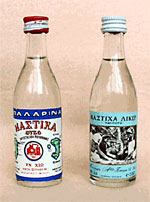Chios Mastiha
A request that this article title be changed to Chios Mastica Liqueur is under discussion. Please do not move this article until the discussion is closed. |
 Mastiha Liqueur (right) | |
| Type | liqueur |
|---|---|
| Region of origin | Greece |
| Alcohol by volume | >15% |
| Colour | transparent crystal clear to yellowish |
| Flavour | Mastic gum |
Chios Mastiha Liqueur (or its official name Masticha of Chios)[1] is a alcoholic liqueur from mastic gum which has a protected designation of origin status in the European Union.[2] The only flavouring agent used in Chios Mastiha liqueur, are either mastic gum alcoholic distillate or mastic oil, from PDO-certified Chios mastic gum.[3] Not to be confused with the term "Mastika" used by Northern Balkanians (hence the hard "k" instead of "h" or "c"). The main -and essential- difference is that "Mastika" is a brandy (explicitly stated the product of fermented grapes and/or fruits) and "Mastiha" is liqueur, the product of mixing or distilling denatured alcohol (see difference between brandy and liqueur).
History
Chios Mastiha Liqueur was quickly embraced by the Greek society since the early 20th century in corporate to their traditions. Halliday (1912) describes "mastic liqueur" as a part of the ceremonial festivities of a Greek wedding in Cappadocia.[4] Mastiha liqueur also became another merchandising asset for the island of Chios.[5]
Flavorant
Mastic is harvested from the mastic tree (Pistachia lentiscus var. chia), a small evergreen shrub that grows to about two to three meters on rocky terrain on the southern part of the island of Chios. This tree takes fifty years to reach maturity, and can be harvested for mastic from its fifth year onwards. Although the mastic tree can be found around the Mediterranean Sea, the variety that produces the aromatic mastic sap only grows in the southern part of Chios. Chios mastic has also been certified by the Agricultural Products Certification and Supervision Organization as part of the Hellenic Ministry of Rural Development and Food.[6]
Ingredients
Chios Mastiha liqueur is served cold and has a crystal clear colour and a sweet aroma. The ingredients are mastic oil and/or distillate, water, denatured alcohol and sugar.
Production
Process is regulated by Greek law and incorporates the flavouring of potable ethyl alcohol (alcohol) with mastic oil by agitation or distillate of mastic gum with ethyl alcohol and subsequent dilution of the latter alcohol solution in sugar-water.The final minimal alcoholic strength by volume of Mastiha liqueur shall be no less than 15 %, as any other liqueur.
Producers and distributors
Chios
- The Growers' Spirit is a producing company run by the Chios Gum Mastic Growers Association (CGMGA).[7] The CGMGA offers Mastiha liqueur made with both mastic distillate and mastic oil in two different variants: Kentos (20% alcohol) and Enosis (30% alcohol).
- Apallarina Chios Distillery
- Kakitsis Chios Distillery
- Psychis Chios Distillery
- Stoupakis Chios Distillery produces Homericon Mastiha liqueur, which contains mastic distillate.
Wider Greece
- Skinos, based in Athens.
- Finest Roots, based in Kalamata, produces Roots Mastiha.
- Mavrakis, based in Patra.
United States
- Ambrosia Group, based in Miami, produces FOS Greek Mastiha.[8]
- YA Mastiha
See also
References
- ^ "Regulation (EC) No 110/2008 of the European Parliament and of the Council of 15 January 2008 on the definition, description, presentation, labeling and the protection of geographical indications of spirit drinks and repealing Council Regulation (EEC) No 1576/89". p. 38.
{{cite web}}: Cite has empty unknown parameter:|dead-url=(help) - ^ "DOOR". ec.europa.eu. Retrieved 2017-08-19.
- ^ http://ec.europa.eu/agriculture/quality/door/list.html;comboName=Masticha%20Chiou
- ^ Halliday, W. R. (1912-03-31). "A Greek Marriage in Cappadocia". Folklore. 23 (1): 82. doi:10.1080/0015587x.1912.9719510. ISSN 0015-587X.
- ^ Ogilvie, A. G. (1943). "Population Density in Greece". The Geographical Journal. 101 (5/6): 251–260. doi:10.2307/1789629.
- ^ http://www.agrocert.gr/pages/category.asp?lang=en
- ^ https://mastihaworld.co.uk/
- ^ http://www.miaminewtimes.com/restaurants/fos-greek-mastiha-go-greek-at-the-setai-8141535
